iPod SOLVES A PROBLEM
SEALER HANDLES VARIABLE SPEEDS
TOTANI SHOWCASES SUSTAINABLE BOX POUCH DESIGN
PLA SHRINK FILM DEBUTS
NO-TANK FILLER CLEANS QUICKLY
CASE PACKER’S ROBOTICS, VERSATILITY CAPTURE ATTENTION
BAGGER INTEGRATES ‘KANGA JAW’ TECHNOLOGY
MODERN PACK APPEALS TO A NEW GENERATION OF TEA DRINKERS
ECONOMY’S IMPACT STILL TO BE FELT BY PMMI MEMBERS
SUN CHEMICAL OFFERING FREE ENERGY FOOTPRINT CALCULATION
THE BUZZ ON LINERLESS LABELS
PLANK FOAM CONSISTS OF UP TO 60% RECYCLED CONTENT
LINE GUIDE SENSOR REDUCES PRINTING REQUIREMENTS, COSTS
SYSTEM NON-DESTRUCTIVELY ANALYZES OXYGEN PERMEATION
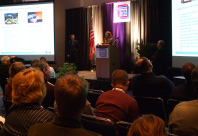
WAL-MART IMPROVES SCORECARD
To a packed room and attentive audience, Amy Zettlemoyer-Lazar, packaging director, Sam’s Club, and Robert Parvis, manager of packaging, Sam’s Club, gave a quick yet comprehensive overview of improvements that have been made to the Sustainable Packaging Scorecard. More modifications are planned, too, and will be announced the week of April 13 at the Wal-Mart Sustainable Packaging Expo in Bentonville, Ark.These changes are designed to make it easier for vendors to populate the scorecard. According to Zettlemoyer-Lazar, 90% of items sold through Sam’s Club have been entered into the scorecard, and 250,000 items sold through Wal-Mart.
Improvements already made include:
--A “Copy To” function, which speeds up data entry for multiple products that use the same packaging.
--The ability to separate samsclub.com items from those products sold in the store so Wal-Mart can better track the completion rate of data entry from its suppliers.
According to Zettlemoyer-Lazar, possible future changes may include:
--By 2010, record the recovery rate for recycled materials by package type rather than by industry average. Her example was that PET clamshells now enjoy the same score as PET bottles, even though they’re not recovered at the same rate.
--Information on the country of origin of the raw materials or where the materials are converted because this will change the number of greenhouse gas emissions used in the material’s manufacturing.
--How to incorporate information on product damages.
--Add information on greenhouse gas emissions for package manufacturing. “It’s important that we get that information so we can change our goals to not being driven just by weight reduction of packaging, but by greenhouse gas emissions,” Zettlemoyer-Lazar says.
A decision on these possible future changes is expected by next month (December).
Zettlemoyer-Lazar also outlined the timeline for roll-outs of the Scorecard to Wal-Mart’s international markets, including China.
Lisa Pierce, Editor-in-Chief, Food & Beverage Packaging
iPod SOLVES A PROBLEM
Oystar JonesBooth #: S-830; 859-801-1778
At Pack Expo, Oystar Jones introduced an innovative solution using an off-the-shelf product. The problem? Making good instructions for changeover available to the technician doing the work. The solution? An iPod Touch video/music player.
Here’s how it works:
Oystar Jones shoots video of one of their technicians performing a machine changeover. As they shoot the video, they also provide a verbal description of the process.
After editing, the video is loaded on the iPod and provided to the end user’s technician. They use the standard strap to mount it on their forearm for easy visibility. Wireless Bluetooth headphones provide the audio with no wires to get in the way.
To perform the changeover, the operator simply follows the step-by-step on-screen and in-ear instructions. Standard touchscreen controls permit fast forwarding, pausing or rewinding.
No more dogeared, out of date SOP’s or manuals. All the information is right at hand. Or at least right at arm.
John Henry, Machinery Matters columnist, Food & Beverage Packaging
SEALER HANDLES VARIABLE SPEEDS
Enercon Industries
Booth #S-466; 262-255-6070
Packagers who use induction sealing on a line that varies in speed will be able to apply seals more consistently with Variable Sealing Control from Enercon. Containers that pass under an induction sealer that uses the same level of power at all times run the risk of getting burned when they pass slowly, or getting an inadequate seal when they travel quickly. Variable Sealing Control, an option on most Enercon equipment, adjusts the sealer’s level of energy to the containers’ speed.
“It’s not a one-to-one relationship” between the line speed and the sealer, says Mark Plantier, Enercon’s vice president for marketing. “Our engineers had to find the right algorithm to adjust the energy.” The sealer ties into the PLCs of upstream conveyors to adjust the energy level accordingly.
Pan Demetrakakes, Executive Editor, Food & Beverage Packaging
TOTANI SHOWCASES SUSTAINABLE BOX POUCH DESIGN
Totani Corp.Booth #E-7130; 920-593-8700
The Green Bay, Wis.-based supplier is featuring its new, popular Totani Box Pouch, which the company touts as “ecology meeting economy.” The unique package reduces the material required, makes efficient use of store shelf space, offers a true flat bottom for stability, includes up to five panels of registered graphics and may be reclosable with use of a top-mounted slider, zipper or spout.
Totani is also demonstrating one of its most recent sales, the CT-60D pouch manufacturing system, highlighting both the machine’s speed by operating at 150 bags per minute and its versatility by assembling bags with Pactiv closures fitted in-line. The machine was recently sold to Accredo Flexible Packaging of Sugar Land, Texas, a suburb of Houston.
Sayre Kos, Associate Editor, Flexible Packaging
PLA SHRINK FILM DEBUTS
Bemis/ClysarBooth #S-2505; 920-303-7331
PLAnet, a compostable shrink-wrap film, was formally rolled out Sunday. PLAnet, made from Natureworks PLA (polylactic acid) resin, has no oil-based components. It uses 35% less fossil fuel and contributes 45% less greenhouse gases than the production of competing oil-based shrink film, says William Hare, Clystar’s vice president of sales and marketing. It is fully biodegradable, with a 90% reduction in mass after 10 weeks in a standard landfill.
Operationally, PLAnet has various advantages. It has a shrink initiation temperature of about 30° F. lower than competing polyolefins or polypropylene, leading to lower energy costs. It has excellent sealability, is able to run on most existing seal equipment and is shrunk in both the machine and transverse directions.
“Brand packagers can reduce their environmental impact without giving up processing characteristics or impact on the shelf,” Hare says.
PLAnet is a stiff film and is not recommended for side-seal applications, although a version suitable for side-seal is expected in about a year. Users of PLAnet can expect to pay a premium ranging from 5% to 50% over standard shrink films, depending on the application, Hare says.
Pan Demetrakakes, Executive Editor, Food & Beverage Packaging
NO-TANK FILLER CLEANS QUICKLY
SeracBooth #S-2460; 630-443-7976
A new net-weight filler from Serac pipes product directly to the filler heads, which remain under constant pressure from a small pressure vessel. Speeds of 800 containers per minute are possible. This patented concept minimizes cleaning between products. A clean-in-place cycle takes just three minutes, with two or three cycles needed to complete the cleaning. Total time: about nine minutes. The closed-loop system reduces water consumption for cleaning by about 70%.
Lisa Pierce, Editor-in-Chief, Food & Beverage Packaging
CASE PACKER'S ROBOTICS, VERSATILITY CAPTURE ATTENTION
Bradman Lake Inc.
Booth # S-1248; 704-588-3301
Combining the tasks of three separate machines, Bradman Lake’s new robotic AX Case Packer can erect, load and close the top flaps of RSC- and HSC-style corrugated cases at a rate of up to 120 cartons per minute and 12 cases per minute. The case packer’s combination of robotics and servo motor drives wasted no time catching attention on the exhibition floor. After only a few hours, Bradman Lake already had sold three AX Case Packers, according to marketing coordinator Mervat El-Rafei.
The AX, which launched this year, features a compact footprint and can be customized to specific uses, depending on packagers’ needs, including the use of glue, tape or both for sealing. A modular infeed design also allows both carton in case formats and layer patterns to be varied according to user preferences.
Carolyn Chapin, Managing Editor, Refrigerated & Frozen Foods
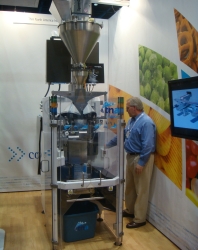
BAGGER INTEGRATES 'KANGA JAW' TECHNOLOGY
tna North AmericaBooth #E-6504; 972-462-6512
Bringing a new generation of bagging machinery to the show floor, tna introduced its robag 3 with “kanga jaw” technology, which makes high-quality gusset bags at high speeds.
“This mating of vertical control in a rotary jaw system has never been offered in the marketplace, and adds a new dimension in tna’s rotary jaw evolution,” says Michael Green, vice president Americas of tna North America. “This adds the flexibility for specific technical needs or bag formats and an increased tolerance for film structures.”
It offers fast batch changeover capability and a broader choice of bag formats. The “kanga jaw” also lets operators switch between producing pillow pack and a block or quarto bottom without having to purchase new bagging machinery.
Randy Hofbauer, Associate Editor, Food & Beverage Packaging

MODERN PACK APPEALS TO A NEW GENERATION OF TEA DRINKERS
PTI Packaging SystemsBooth #S-340; 973-252-6039
Tstix inventor Geoff Stuart is enthusiastic about how the “cool factor for youth for this modern packaging concept is good for the tea industry.” Consumers simply stir the Tstix, a perforated stick pack filled with pieces of tea, to brew a smooth-tasting cup of tea. PTI Packaging Systems is the U.S. agent for the package. Alcan Packaging provides the pre-perforated materials, including a polypropylene film designed to handle boiling temperatures (212º F. or 100º C.). Schwarze Automation manufactures the stick-pack system, a six-lane machine that reaches speeds of 240 packs per minute. This concept has potential for other granular products.
Lisa Pierce, Editor-in-Chief, Food & Beverage Packaging
ECONOMY'S IMPACT STILL TO BE FELT BY PMMI MEMBERS
Equipment manufacturers usually suffer during economic slow-downs, as capital equipment purchases are put on hold or cancelled outright. However, the first eight or nine months of 2008 were pretty good for packaging machinery sales. More than a couple exhibitors tell me that, although sales in the last two months have dropped off, they’re still working through a backlog of projects. It’s 2009 that holds the big question--how long until the recovery? And that remains to be seen.Lisa Pierce, Editor-in-Chief, Food & Beverage Packaging
SUN CHEMICAL OFFERING FREE ENERGY FOOTPRINT CALCULATION
Sun ChemicalBooth #E-9107;708-236-3713
Sun Chemical, strategically partnered with consultant ENVIRON, is highlighting its environment services program, SunCare, by giving away one comprehensive energy footprint consultation at the winner’s plant upon the conclusion of Pack Expo. During the show, representatives from Sun Chemical and ENVIRON are offering simple evaluations of attendees' plants based on a plant's location in the U.S. or Canada, square footage and amount spent on various energies, including electricity, natural gas, heating oil and propane. (The reports being printed at Pack Expo account only for on-site energy use and do not account for emissions from chemical processes, transportation or use of product or other sources.)
Printouts from the free, simple calculation list figures for carbon dioxide emission factors, carbon intensity, and most striking of all, a plant's carbon footprint expressed in number of cars able to operate for one year, barrels of oil and acres of pine forest.
Sayre Kos, Associate Editor, Flexible Packaging
THE BUZZ ON LINERLESS LABELS
Are linerless labels more viable in today’s sustainable environment, I asked Tom Michalsen, director of marketing,Weber Marking Systems(Booth #S-2440). He answers that he hasn’t seen a demand for linerless labels. But to address the sustainable point, he tells me that the majority of film liners are polyester and can be recycled: most label users are just not aware of that. And, because of the release coating on the facestock, linerless label are difficult to code with variable information. Perhaps linerless label manufacturers could provide a clean area on the label for online marking purposes, critical today for track-and-trace and personalization.Lisa Pierce, Editor-in-Chief, Food & Beverage Packaging
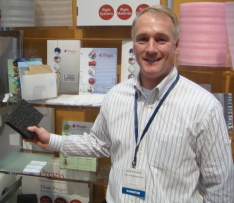
PLANK FOAM CONSISTS OF UP TO 60% RECYCLED CONTENT
Pregis Corp.Booth #E-6517; 800-834-9441
Demonstrating sustainable effort, Pregis unveiled its PolyPlank Renew, a mid-density foam plank grade containing up to 60% pre-consumer recycled content. The product, a suitable alternative for foam plank cushioning applications, has a density of about 1.5 pounds per cubic foot. It is also available in up to 48-inch width and in 0.5- to 3-inch thicknesses. It is water resistant and has strong shock protection.
Randy Hofbauer, Associate Editor, Food & Beverage Packaging
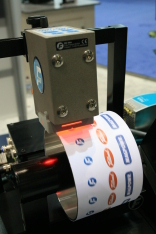
LINE GUIDE SENSOR REDUCES PRINTING REQUIREMENTS, COSTS
Fife Corp.Booth #S-2405; 800-639-3433
Fife's new SE-46 line guide sensor eliminates the need for a "striker line" (and inherent waste) and looks to existing one-dimensional graphics, like bar codes or printed borders, to guide a web. Requirements for these existing printed elements are minimal: The sensor can “see” lines as narrow as 0.02 inches. What’s more, the clearance between printed elements required by the SE-46 is reduced to 0.008 inches, further expanding the range of potential printed elements used to track a web.
Sayre Kos, Associate Editor, Flexible Packaging
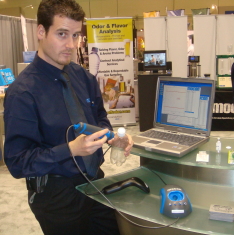
SYSTEM NON-DESTRUCTIVELY ANALYZES OXYGEN PERMEATION
MoconBooth #E-7510; 763-493-6358
Mocon introduced its OpTech–O2platinum, which uses optical fluorescence technology to analyze oxygen levels without damaging packaging. The platinum chemistry used gives off light in an amount related to the amount of oxygen. The fluorescence can then be read optically. This makes the technology suitable for non-destructive permeation analysis, leak determination and headspace and dissolved oxygen analysis.
Randy Hofbauer, Associate Editor, Food & Beverage Packaging
